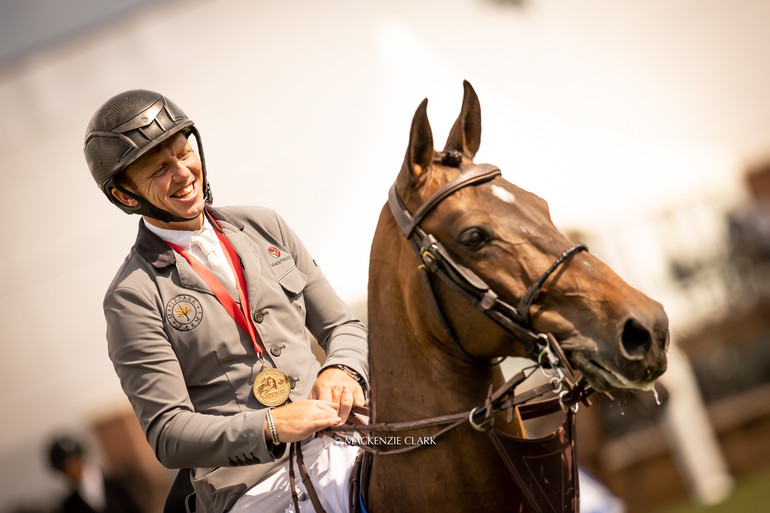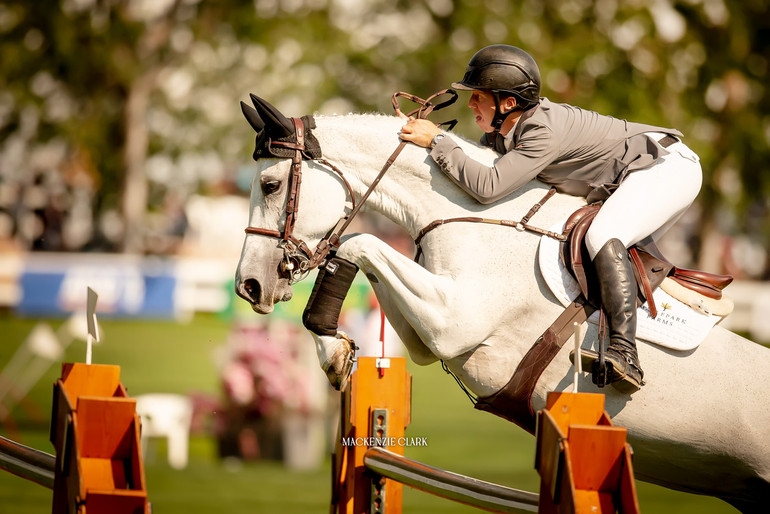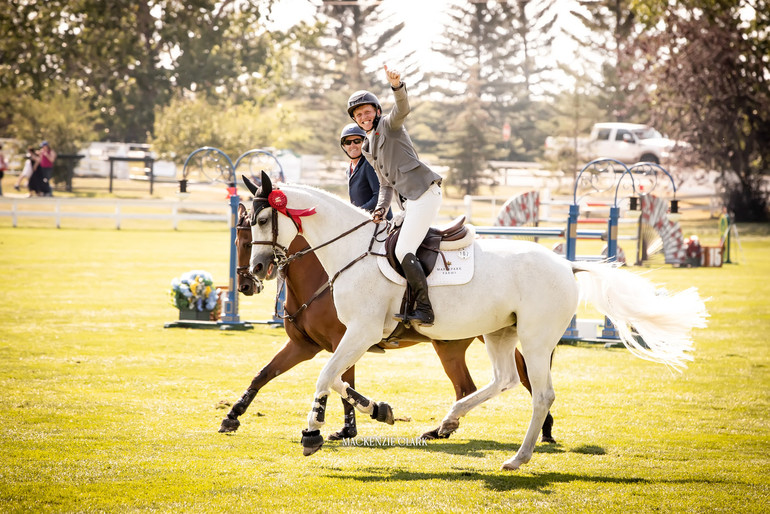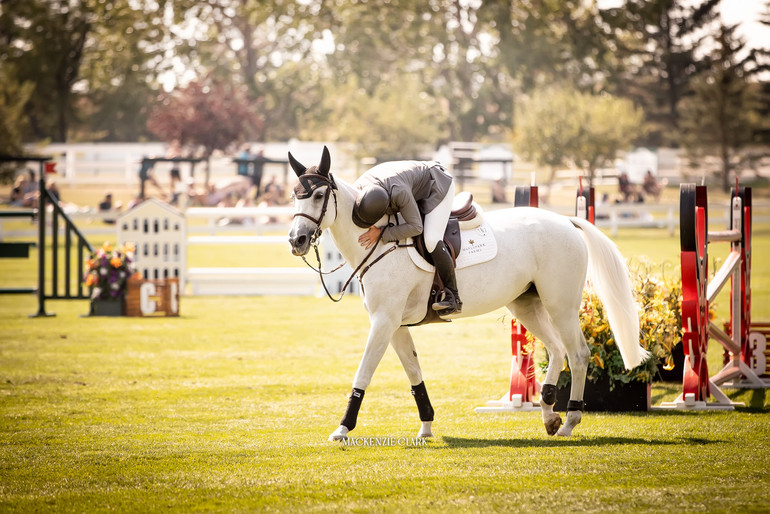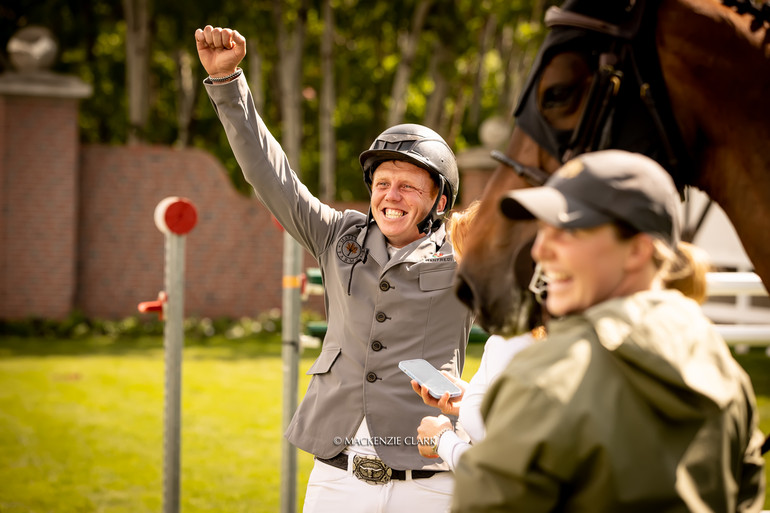Text © World of Showjumping
Great Britain’s Matthew Sampson has had a fantastic summer season in North America. Competing in Canada for over three months, Matthew received the Spruce Meadows’ Xerox Rider of the Year Award after recording 17 wins at the venue this summer. With Fabrice DN (Emilion x Baloubet du Rouet), Matthew also took his first ever five-star Grand Prix win when topping the RBC Grand Prix of Canada, presented by Rolex, during the CSI5* Spruce Meadows ‘National’ in June and on Ebolensky (Clinton x Heartbreaker), he tied for the first place with Ireland’s Paul O’Shea in the CSIO5* 1.60m Friends of the Meadows Grand Prix, presented by Rolex, during the CSI5* Spruce Meadows ‘Continental’ in September.
Currently ranked 60th on the Longines Ranking, the 32-year-old – who dropped out of school when he was twelve – speaks to World of Showjumping about time and confidence, and how competing in North America was his only chance of getting into the bigger shows. “One of the reasons we went to Canada was that I felt I had the horses for the biggest shows, but it is very difficult to get into those events in Europe,” Matthew explains.
Ponies instead of school
Matthew was born into horses: His parents Ruth and Sam own Parklands Equestrian Centre at Aston, Sheffield, and since his older brother and sister did not ride, Matthew did not have much choice. “We had a lot of horses and my siblings did not ride, so my mom and dad had to make sure one of us did,” he laughs. “I rode ever since I was a baby, really. I left school when I was twelve, and got home schooled a few hours every week, but have basically just ridden since then. We did a lot with ponies; I rode for other people already when I was younger. From a very early age I decided this was what I was going to do. When I turned sixteen, I went to work for Duncan Inglis and rode for him in England. Duncan gave me an education in the horse-side of things, as I was coming off from ponies at the time. I worked for Duncan for two and a half years, and then moved on to work for Henk Nooren. After about two years with Henk, I started my own business, based in Yorkshire.”
Today, Matthew and Canadian showjumper Kara Chad run a business together – Maplepark Farms. “I met Kara when she was working for Eric Lamaze,” Matthew tells. “After having been together for about a year, we decided to start a business of our own and have quietly built it up since then. We have named it Maplepark Farms because Kara is from Canada, hence the Maple, and with a nod to my parents’ Parklands as well. We don’t have a all-year-around base; we share our time between Europe and North America. Over Covid we were based at my yard in Yorkshire, and then we went to Canada for the summer and Spain for the winter. It is always difficult to start up anything new, and during Covid it was especially not easy. However, this year has been great; we have met a lot of people and sold some horses to both America and Europe – things are starting to get going.”
The best of both worlds
While Matthew and Kara come from very different training backgrounds, they have taken the best from both worlds and combined it into a system that works well for them. “I have grown up in the European system and Kara in the American, and it’s two very different approaches to the sport,” Matthew tells. “However, we work well together and bounce off each other’s ideas, and I think our different backgrounds have only come to be an advantage for us. I suppose the biggest thing is that Europeans focus more on young horses. It is much more expensive to develop and raise horses in America or Canada, so the riders there are more inclined toward older horses whereas in Europe, we focus on the production of young horses.”
Matthew and Kara do both training and trading, and have a couple of clients that they coach as well. “We have both competition horses for us, as well as sales horses,” Matthew explains about the operation at Maplepark Farms. “For myself, I have got a really good team of horses at the moment, with six older ones. In addition, between the two of us, we have about 12 younger horses from the age of seven and under, as well as a few horses I have bred myself that are starting up now. I do a bit of breeding myself: The broodmares and foals are in England. We have about twelve foals on the ground now, with two or three born every year, so the numbers are not huge. However, I like the excitement of breeding horses, hoping they will turn into Grand Prix prospects in the future. I like the thought of watching them grow and being in control of the horses and their upbringing from the very beginning. Another reason to breed, is that it is so hard to find good horses; we try to make them ourselves instead. I don’t really have the financial support to be able to buy those ready Grand Prix horses, so it is important to try and create them.”
“My parents have always had a huge influence on my riding career,” Matthew continues. “Both of them rode and they have always helped me, they are always there for me. Another person who has had a massive impact on my career is Duncan Inglis – who I worked for when I was 16. He really helped me a lot in the start of my career, and he still does if I am unsure or need advice. Horse-wise, I have been lucky to have some really good horses, and my current best horse is Geneve R (Eldorado x Berlin). He has been my first horse for five-star Grand Prix level, and gave me some great opportunities last year – helping me climb on the ranking list and getting us into some bigger shows. Ebolensky and Fabrice have both been amazing as well; they each won a five-star Grand Prix this year and have really helped me further my career to the next level.”
At home on the big grass rings
When speaking about his great summer at Spruce Meadows, Matthew is full of praise for the iconic Canadian venue. “The place is just incredible, and to be able to compete there all summer like we did, and to jump the ‘Masters’ – I think it is every rider’s dream,” he says. “For it to go so well made it even better; it was really a fantastic season. All our horses really liked the venue with the grass ring, that really worked in our favour. Every horse jumped great, and the results we had kept everyone feeling in top form – I could not have wished for a better tour.”
“I think what makes the venue at Spruce Meadows so special, is first of all the history behind all the competitions there,” Matthew continues. “When you read the names carved on to the trophies, those have all been won by the riders I looked up to when I was younger. I think that is a huge part of the attraction, and also the crowds; they are incredible. I don’t know how many thousands were there, but they really love the sport and get behind every rider no matter where you are from. Also, the facilities for the horses are fantastic, the ground is great – then everything from the stables to the number of arenas, it really is such a special place. The effort that the organizers put into the venue is just incredible. I have grown up competing on grass, and I think for me it is definitely my favourite type of surface. Luckily for me, all my horses really like it, too. Obviously, most of the shows in Europe have amazing venues for producing horses, but I think for the big days and the biggest shows – like Spruce Meadows, Aachen, Hickstead and Dublin – those grass rings are iconic and I think it is great that we still have them. Winning my first five-star Grand Prix at Spruce Meadows was the highlight of my career so far. It was something I had tried to do for a long time, and to do it at that venue – which is probably one of my favourite shows as well – it really meant a lot for me.”
Horses come before the sport
While Matthew is very ambitious, his love for horses outweighs that for the sport. “I absolutely love horses. I love the sport, but I love the horses before anything else,” Matthew tells. “I really love to try and get the best out of the horses, but it is important for me to feel that they are happy doing their job – that feeling is what I love most. I try not to over-jump my horses and focus on one show at the time. I aim to go and get the best results, in not too many classes – that is sort of my philosophy. I make a plan for each horse and try not to worry too much about the ranking. I hope that by getting results we will naturally climb up. It is very difficult though; it is hard to climb without the risk of over-jumping your horses. For me, I try to make a plan that suits my horses first and foremost, and if that leaves me lower on the ranking, then that is how it has to be. I want to keep my horses jumping on the higher level for a long time.”
One of the reasons for Matthew’s tour in North America is the current invitation system that is tied to the Longines Ranking. “I felt I had the horsepower to do five-star shows, but getting into them in Europe when you are not up on the ranking is nearly impossible,” he explains. “And without getting into the bigger shows, it is very difficult to climb on the ranking. It is a complicated system. Hopefully, competing in Canada has helped me and moved me up the ranking a bit, so that I can get into some of the five-star shows in Europe as well. I do think it is a very challenging part of the sport to manage as a rider because it can be frustrating: You might have the horses that you want to do bigger shows with, but you can’t get in. That encourages people to compete at the lower star-levels, but doing so does not develop the horses into five-star horses. It is a vicious circle, but it is how it is, and we have to keep working around it.”
“If we could give riders who have horses going well in any given moment, a chance to get into bigger shows based on their current results rather than the rider’s ranking, that would help,” Matthew reflects on a possible solution to the issues with the current invitation system. “Sometimes you see riders who are ranked high because their horses were in shape the previous year, that keep going to the biggest shows even if they don’t really have the horses for it anymore. For sure the system could be better, and give more horses and riders a chance.”
Building towards championships
This winter, Matthew will be based in Spain. “We will stay in Vejer de la Frontera and do the Sunshine Tour, and I hope to do some World Cup shows with my older horses,” Matthew tells about his plans for the coming months. “We are also planning to head to Florida with some sales horses for a few weeks, and then come back for Sunshine Tour. We really like Spain very much, we have a good base there at the showground. It is nice for the horses and there are plenty of shows down in the area for the younger horses to be produced around. Brexit has made it very difficult to get the horses over to Europe for the shows, and also very expensive – that is another reason for us staying in Spain.”
“I would really like to make it into a British championship team, that is my big goal for the next couple of years,” Matthew continues. “I have been striving towards that ever since starting my own business. My goal until now has been to build up a team of horses for five-star level. Now we are getting there, and it is nice to have more than one horse that can do those classes. I want to keep building our stable and the team of horses for both me and Kara. Obviously, you need to have the right horsepower to be able to break into the championship squad, but I think I do have that now. I just got to keep building them up and really aim them for those major events. I think once you have the right horse at the right time, being a part of the British championship team should be more than possible. Breaking into it, hopefully with the horses going as they are at the moment, won’t be too far away.”
“However, you need to give horses time,” Matthew points out. “If you believe in a horse, give it time; you cannot rush what the horses can give you or what they are ready to do. One of my best horses is thirteen and only did her first five-star Grand Prix this summer – which she won. I felt she was not ready for it until then, so I never pushed her to do it earlier. I think it is important for younger people to understand this; often you see riders rushing to show their horses, pushing their horses too far when they are not ready. Give the horses time, and believe in the horses you have – that has been one of the biggest lessons I have learned.”
Confidence is key
Matthew believes confidence is key when competing, and his winning streak at Spruce Meadows seems proof of just that. "No matter how good any rider is, confidence plays a key part in our sport,” Matthew explains. “When you do get a good win – and especially one you have been trying to get for a long time – it is a great confidence boost and I think it has an impact on your other horses as well. Having a good win takes the pressure off a bit, and as a rider, your own confidence has a massive impact on your horses; they feel it too, it is contagious. Confidence is definitely something that can put you on a bit of a roll; when things are flying high, it keeps you going – I think it happens to many riders.”
“I think obviously we are always striving to get better, but sometimes when things aren’t going according to plan it is easy to over-think things and dwell on what is going wrong,” Matthew continues. “All that comes down to your confidence; if you lack a bit of confidence, you are not sure about the decisions you make. It is only natural as athletes to sometimes blame ourselves for the decisions we make, especially if we make mistakes. For me, I have found that it is really important that I feel confident; I believe you ride better then.”
No reproduction without written permission, copyright © World of Showjumping.com



